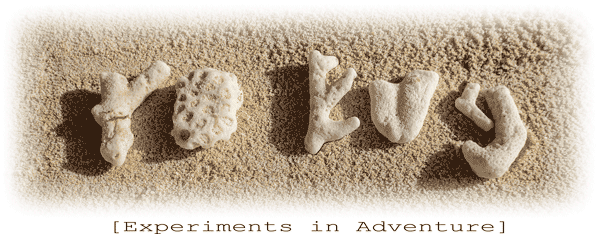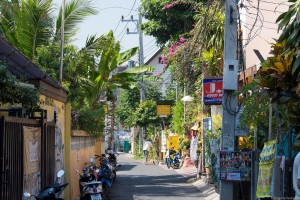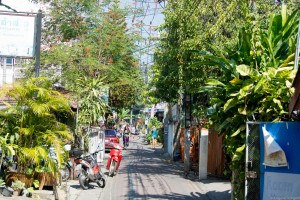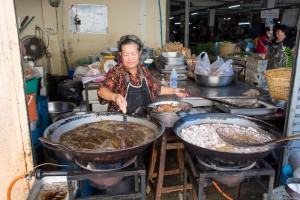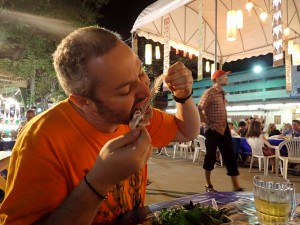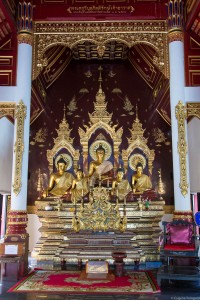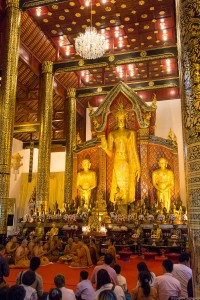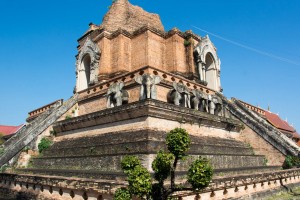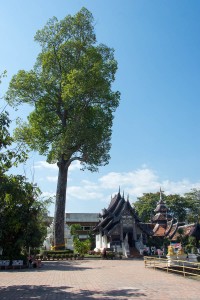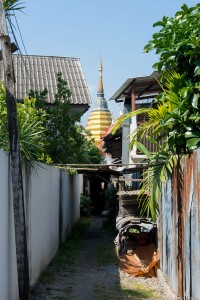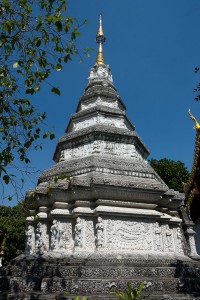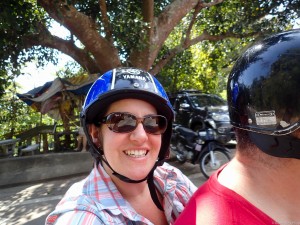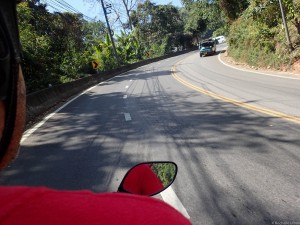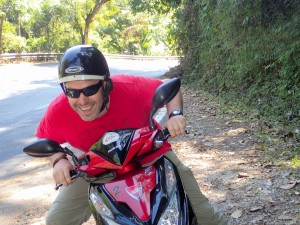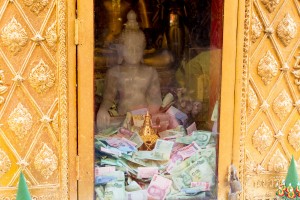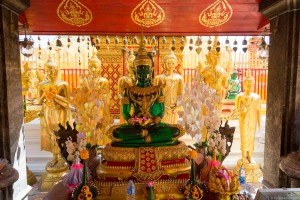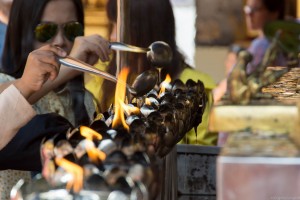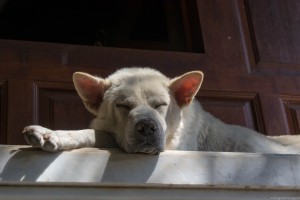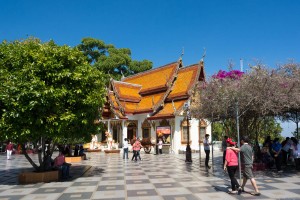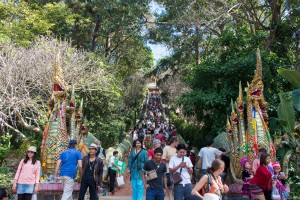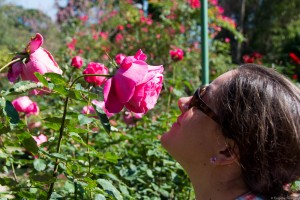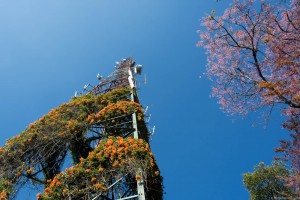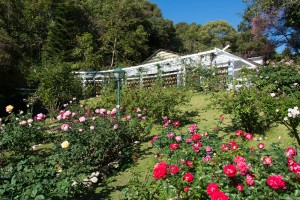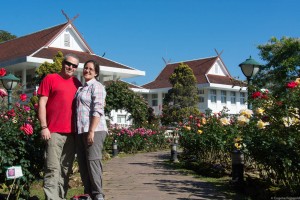Having not stayed on Khao San Road in Bangkok, Chiang Mai was our first exposure to a backpacker area. Firstly, it turns out “backpackers” aren’t just white 22 year olds scraping by on $20 a day. Sure, they are the largest group, but they constitute only about 40% of all travelers. 30% are retired white people, 20% are Chinese or Korean families/groups, and the remaining 10% are like us — not quite 22, and not quite retired.
Most of the touristy bits of Chiang Mai fit within the old walled/moated city — a 1.5 km x 1.5 km square.
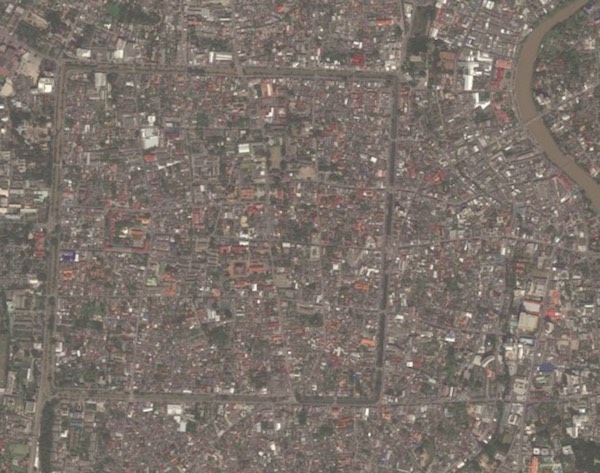
Hotels, guesthouses, hostels, restaurants, cafes, food carts, bars, clubs, tour agencies, tchotchke vendors, tuk-tuk hustlers, and of course numerous wats occupy most of the space. While there are still some people who live there, it feels that more and more of them are getting forced out in favor of some latest guest house or restaurant. I guess they have the same gentrification issues as poor areas of western cities, except here the old flavor of the city is slowly being replaced by tourists who are there one day and gone the next. In the 3 weeks between Chiang Mai and the writing of this post, we have seen various stages of this pattern taking hold in Thai, Lao, and Cambodian cities.
But I digress. The city is lovely, full of tasty food, tasty drinks, friendly people, and lots of things to do – both in town, and as a jumping-off point to a myriad local activities – such as cooking classes and elephant visits.
- The streets of Old Chiang Mai
- Farang are abundant in Chiang Mai
- Fried chicken lady. There’s a lady for everything.
- Can’t waste any of the night market grilled fish!
The 2.25km2 old city is home to several dozen wats of various sizes, ages, blingery, and disrepair. Most were empty and quiet – as a wat should be. Only a couple of the more famous ones were overrun by tourists. We spent a few of our days simply wandering around town, wat peeping and taking in the culture.
- Inside on of the many wats in Old Chiang Mai
- Ceremony in the newer temple at Wat Chedi Luang
- Elephant on the old part ruins of Wat Chedi Luang
- Tree : Wat
- Stupa view
- Mustachioed Buddha Stupa
On our second day in town, we did what just about every tourist in Southeast Asia does – rented a motorbike for the day. Since Rochelle was feeling less than confident riding through Thai traffic, we rented one scooter for both of us. After we got our little Honda 150 (which we later learned had a weight capacity that we exceeded a bit…), we took a couple terrifying laps around the old city and we were ready to go. We were headed up to Doi Suthep, a mountain just 15 km west of the city. The road up is full of curves and switchbacks, but thankfully not a ton of traffic.
- Not terrified at all on the back of the scooter!
- Scootering up the road of Doi Suthep
- A man and his bike
Our main destination was Wat Phrathat Doi Suthep, a 600-year old temple that overlooks Chiang Mai. There is a lot of history mixed with legend here. According to the story, a white elephant carrying a piece of a relic was left to roam the jungle and trumpeted three times then died. So they built this wat there. This wat is a very popular pilgrimage destination for Thais, and as a result the number of donation boxes, offerings for sale, and other requests for money is astounding. Money is everywhere. That said, it is a beautifully golden temple and probably has a great view of Chiang Mai — when the air quality allows.
- So much baht at the wat
- Emerald (not really) Buddha
- Without constant ladling by worshippers the leaky oil lanterns would quickly run out
- Wat dog nap
- The grand staircase up to the wat
After the wat, we continued up the road for a few more kilometers to check out one of the king’s winter palaces. It is known for its gardens full of exotic (to Thais) flowers like roses and tulips (up there it’s cool enough for them to grow). The garden was quite indeed full of roses, but there wasn’t a whole lot else to see. On our way back down the steep curvy road I only overheated the brakes once before realizing that a little gas puts the automatic scooter in gear and allows engine braking. Luckily the terrifying feel of the brake lever going soft only happened when we were already going slow…and there is a redundant mechanical brake.
- Smelling the King’s rose
- The King’s cell tower
- The King’s trellis
- In the rose garden of the Doi Suthep Royal Palace
Overall, we really enjoyed our time in Chiang Mai and could see spending a lot more time there. But we wanted to get back on the road – we rented a car to see more remote Northern Thailand. More on that adventure to come!
